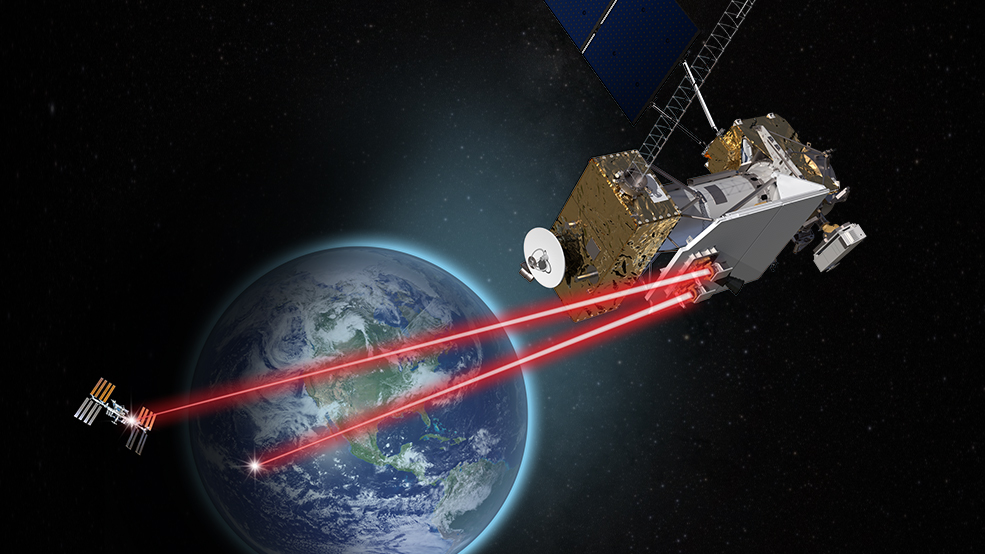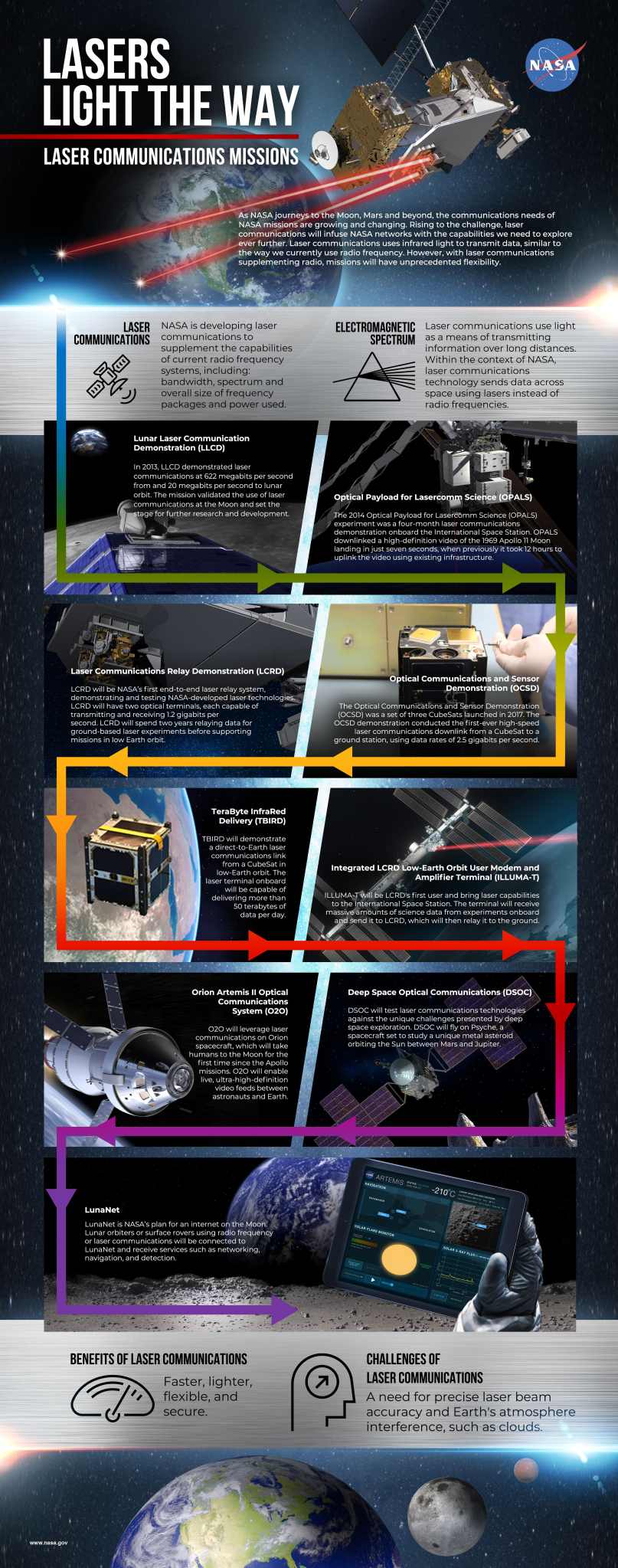Editor’s Note: Find a more up-to-date article on NASA’s laser communications roadmap here.
Laser communications will revolutionize the way NASA sends and receives information to and from space. Leveraging the advantages of infrared light, laser systems will provide missions with extraordinary data capabilities, leading NASA into the next era of space communications. This summer, NASA will launch the Laser Communications Relay Demonstration (LCRD) to test the validity of laser systems. However, LCRD is just one laser communications mission on the road to operational laser communications with both predecessors and follow-on missions.
Download a pdf of the Laser Communications Roadmap
Previous Laser Communications Missions:
- In 2013, NASA launched the Lunar Laser Communications Demonstration (LLCD), which sent laser communications signals from the Moon at 600 megabits per second, proving this cutting-edge technology 238,000 miles from Earth. This mission set the stage for future laser communications research and development.
- Other previous laser missions include the 2014 Optical Payload for Lasercomm Science (OPALS) experiment – a four-month laser communications demonstration onboard the International Space Station. As well as the 2017 Optical Communications and Sensor Demonstration (OCSD), which conducted the first-ever high-speed laser communications downlink from a CubeSat to a ground station.
Current Laser Communications Missions:
Building upon the success of these missions, NASA will test a variety of laser communications applications.
- Launching in 2021, NASA’s LCRD mission will be the agency’s first technology demonstration of a two-way laser relay system. The mission will test laser capabilities with experiments, one of which will study atmospheric impacts like clouds, which can block or damage laser signals. Similar to how if you block a television remote, you block the signal. Humans already use the concept behind laser communications with their televisions. Using infrared light, remotes send signals to control a television.
- NASA is testing laser communications in both large and small satellites. Although just the size of a shoebox, in late 2021 the TeraByte InfraRed Delivery (TBIRD) mission will demonstrate a burst-like laser downlink of 200 gigabits-per-second (Gbps) – a new record for data rates. With multiple passes a day, TBIRD will send back terabytes of data – roughly 250, 120-minute movies – and give NASA more insight into the capabilities of lasers on small satellites.
- Laser terminals are ideal for spacecraft like the International Space Station because they require less size, weight, and power – a key benefit when designing new mission concepts. In 2022, LCRD’s first orbiting experimental user will be the Integrated LCRD Low Earth Orbit User Modem and Amplifier Terminal (ILLUMA-T) aboard the space station. ILLUMA-T is capable of communicating high-resolution images and videos of ongoing experiments down to Earth for investigation and discovery.
These missions will give NASA increased knowledge about laser communications systems near Earth. As NASA journeys further into space than ever before, missions at the Moon and in deep space will also benefit from advanced communications capabilities.
- NASA’s Artemis II will leverage laser communications, sending back critical data to increase our knowledge of the Moon for when the agency lands the first woman and next man on the surface and establishes a sustainable presence. The Orion Artemis II Optical Communications System (O2O) terminal will enable an ultra-high-definition video feed between Artemis II and Earth.
- NASA’s laser communications endeavors extend into deep space as well. Launching in 2022, the Psyche mission will embark on a three and a half year journey to reach its destination at its namesake asteroid, over 150 million miles away from Earth. During the first year of its voyage, the onboard Deep Space Optical Communications (DSOC) payload will test laser communications against the distinctive challenges presented by deep space exploration – extreme distance pointing. DSOC will give NASA insight into laser communications capabilities farther than ever before, proving these systems are viable for deep space exploration.
With all of these laser missions in development, one might think the night sky will be filled with a colorful laser light show. However, the infrared light used for laser communications is invisible to human eyes.
As use of laser communications systems becomes frequent, the importance of standardization increases. Following common standards for laser communications will eliminate the need for missions to design their systems from the ground up, resulting in cost savings and interoperability between spacecraft.
Through NASA missions, the aerospace community is garnering extensive knowledge about the capabilities and challenges of laser communications in different environments. LCRD, launching no earlier than June 23, 2021, is one of the first steps in showcasing laser communications systems, setting the stage for future science and exploration missions to embrace and standardize this technology.
For more background information on LCRD, please visit:
Laser Communications: Empowering More Data Than Ever Before | NASA
What is the Laser Communications Relay Demonstration? | NASA
…
LCRD is a NASA payload aboard the Department of Defense’s Space Test Program Satellite-6 (STPSat-6). STPSat-6, part of the third Space Test Program (STP-3) mission, will launch on a United Launch Alliance Atlas V 551 rocket from the Cape Canaveral Space Force Station in Florida. STP is operated by the United States Space Force’s Space and Missile Systems Center.
LCRD is led by Goddard and in partnership with NASA’s Jet Propulsion Laboratory in Southern California and the MIT Lincoln Laboratory. LCRD is funded through NASA’s Technology Demonstration Missions program, part of the Space Technology Mission Directorate, and the Space Communications and Navigation (SCaN) program, within the Human Exploration and Operations Mission Directorate.





























